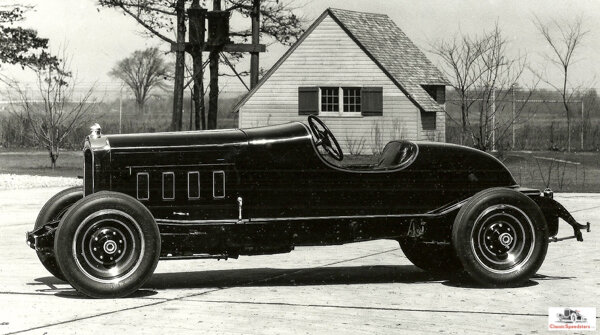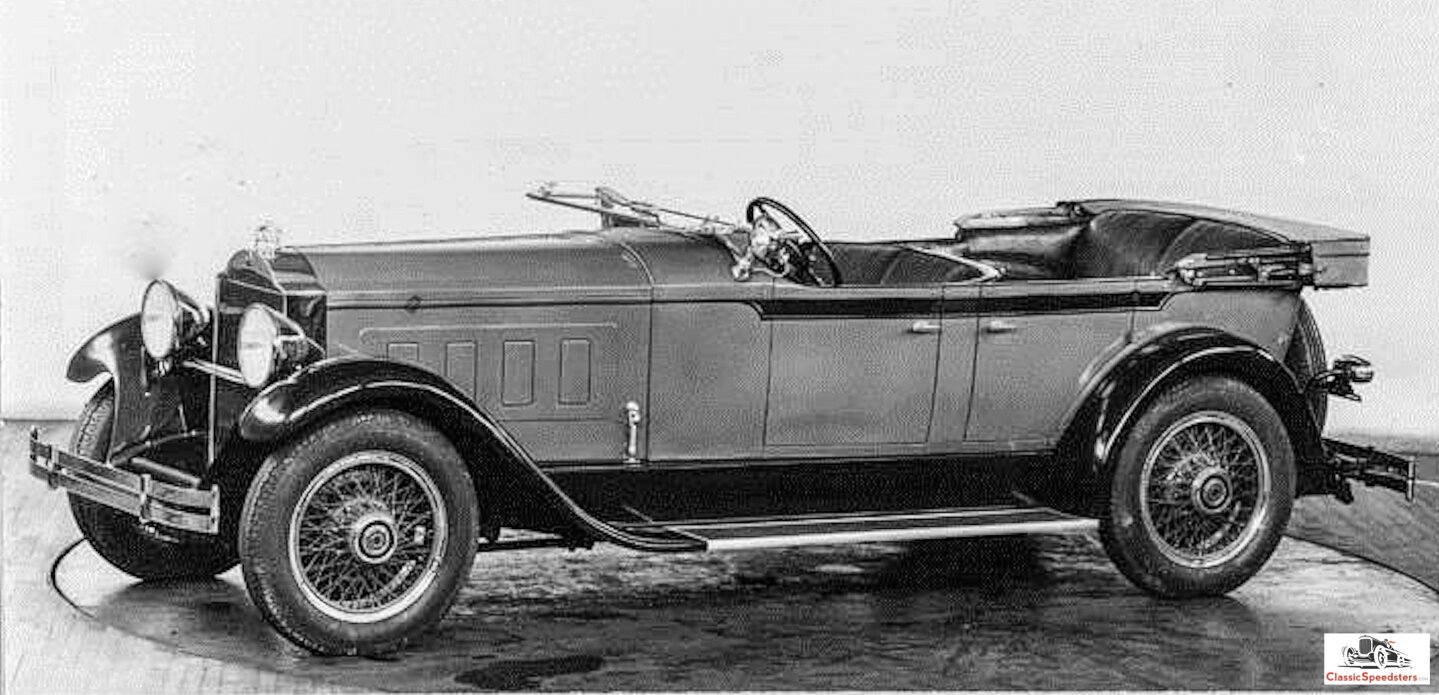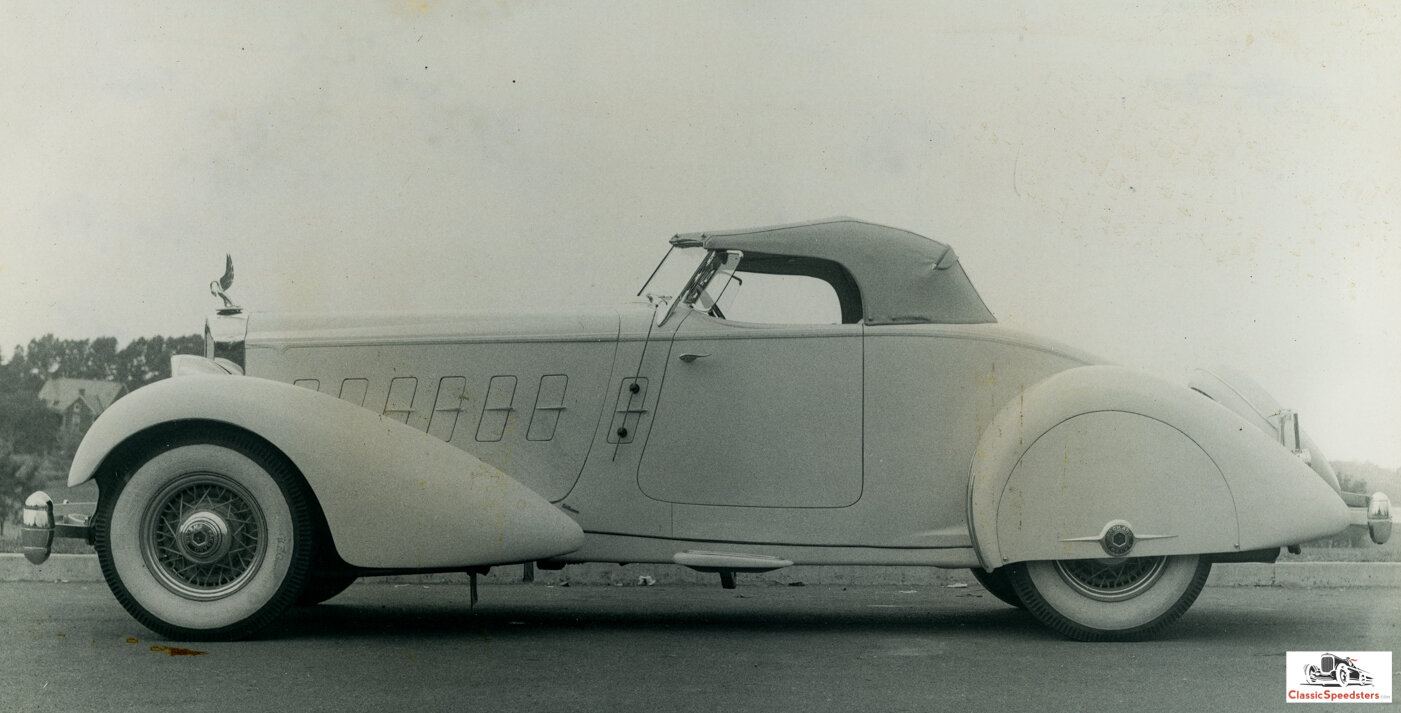Early Packard Forays
Packard, whose speedster story was introduced in a previous post (May 8, 2020), had a recurring history of producing sporting vehicles for the consumer market that were not quite speedsters, while also providing engines and chassis to private racers to use in their own race-winning track speedsters. In addition, Packard provided engines for record-breaking endurance racers on land, sea and air.
The thing is that Packard was, first and foremost, a luxury car company. Therefore, it left the fun work to others–but it also touted their successes using Packard equipage in prominent ads!
1935 Packard Promotional Poster, part of an ad campaign to promote Packard power applications. To summarize the company press release: a Packard Eight drove 3965 miles nonstop from LA to NYC in 165 hrs and 55 minutes; a Packard marine engine powered Rainbow III 1064 miles in 24 hours; twin Packard aircraft engines powered a Navy PN-9 for 29 hours over 2230 miles, a new record; the USN dirigible Shenandoah flew 8100 miles, including over mountainous terrain, also a new record.
Forays into speedster designs by Jesse Vincent, Packard’s chief engineer, often had the support of higher-ups as “experiments,” but sanctioning a significant production run of sporting cars never was a priority for the company. Retailing a street speedster could have put some vim into the Packard showroom, as had been done by a variety of other companies.
Vincent Packard Speedster in 1928. image courtesy William Bailey collection
However, speedsterism was not Packard’s intended path, as they were doing quite well in the luxury car marketplace, thank you very much. Oh, well...
Projects
During Vincent’s tenure, the Packard Proving Grounds was built, a complex with a track the size of the Speedway in Indianapolis and sited about 30 miles north of Indy.
Packard Proving Grounds, as seen from the air in 1933. Packard company photo
And in the late 1920s, while Vincent was experimenting with his track speedster, two board-approved street speedster projects came to production, but without much fanfare, not much overt company support (few announcements, brochures, advertisements, or auto show placements), and with small production numbers of the models in the series.
These appeared to be side-projects to appease Packard President Alvan Macauley, a serious speed fan who probably would have liked to see a decent-sized run of Packard speedsters. However, having the Great Depression occur while producing these speedster model runs did not help the argument that folks needed a Packard sport model in their garages.
Nevertheless, the Sixth Series 626 Speedster Eight was introduced in 1929, followed in 1930 by the Seventh Series 734 Speedster Eight. And, each series produced what could be “classic” speedster as well as some variants of the concept…
626 Speedster Lineup
Despite the impending economic headwinds, about 70 Sixth Series 626 Speedster Eights were produced for 1929. Packard’s idea of “speedster” was to make something lighter, narrower, and minimally accessorized, and this was emblematic in the 626, which adapted a 640 body onto a short 126.5-inch chassis from a Standard Eight model, into which was fitted the 385 CID Custom Eight engine. Producing 130 horsepower and equipped with a muffler cutout, these models were the hotrod of the Packard clan for 1929 and could rocket occupants to over 100 mph!
1929 Packard 640 "Big 8" as seen in Packard sales brochure.
The Roadster configuration for the 626 Speedster Eight was the classic speedster in this group. It had 14 inches sectioned and removed from behind the cockpit, which eliminated the golf bag compartment. This procedure also eliminated about 455 pounds, bringing the car’s weight down to 3830.
1929 Packard 626 Speedster Roadster. Packard factory image
Like other prominent car makes had done, Packard broadened the definition of “speedster” for those who wanted more occupancy, creating a Speedster Phaeton, and for those who wanted a hard top, a Speedster Coupe version was also in the mix. Naysayers would argue that these did not fit the classic speedster definition, but these models were lighter and faster than the usual Packard. So, go figure…
1929 Packard 626 Speedster Phaeton. Factory image
734 Speedster Cousins
The Seventh Series 734 Speedster Eight was designed as an improvement over the 626, and its first requirement was to be something longer and sleeker looking. The Standard Eight 134.5-inch wheelbase was employed, eight inches longer than the 626 chassis, and a 385 CID Deluxe Eight engine was installed. Using high-compression heads and other power improvements, the Deluxe Eight produced 145 bhp.
The most famous version of the 734 models was the Speedster Runabout, which was classic speedster to the nines.
1930 Packard 734 Speedster Runabout at the Packard Proving Grounds. Factory image
However, a hardtop four-passenger Speedster Sedan was available, a Speedster Victoria model, a Speedster Phaeton version, and a Speedster Roadster with a rumble seat in place of the boattail that came with the Speedster Runabout.
1930 Packard 734 Speedster Roadster. This factory image shows how, with a turtleback deck, one could have a rumble seat in the back for the kids!
An experimental 734 Speedster Coupe was made as well, but it was probably not offered to the public.
As sleek and handsome as these models were, they were neither overtly promoted nor extensively advertised. Very few brochures were made, and only 113 Model 734s were produced.
Eleventh Series Twelves: One Last Effort
The Twin Six series of Packards represented the best of the company, an engine tradition that began with the Twin Six (twelve cylinder) introduced by newly-hired Jesse Vincent in 1916. The Eleventh Series of 1933-34 was the final iteration of that venerable design, which also gave witness to Packard’s third (and last) generation of speedsters and speedster variants.
The model line and its engine that had begun in 1916 was retired in the mid-twenties with the advent of the eight cylinder models. But then it was brought back in 1932 to again power its most luxurious models and compete directly with other luxury makes who had been flaunting their twelves and sixteens since 1930. For 1933, the Ninth Series Twin Six model line had undergone a minor redesign and thus were renamed the Eleventh Series Twelves for 1934.
Concurrent with this redesign, Ed Macauley, who had been promoted to Head of Design in 1932, had been experimenting with different body elements on a Packard test-bed car that became both known as the Macauley Speedster and the Brown Bomber. Throughout the 1930s and even in the early 1940s, it would take on different fender, hood, and tail treatments to test different styles emerging from the Packard Styling Division. Macauley’s Brown Bomber probably came out too late to directly influence the design of the Eleventh Series speedster models, but it did show the potential that existed at Packard to throw down a direct challenge to the mighty Duesenberg SJ as well as what came over from Europe.
1933 Macauley Packard Speedster. Ed Macauley is standing next to his 1933 iteration of the car. Not seen is the cockpit interior, which was fitted with an altimeter and a couple of hints that Ed also liked aircraft. factory photo courtesy Skillman Branch, Detroit Public Library.
Count Alexis de Sakhnoffsky had been hired by Packard to work on the Ninth Series Twin Six of 1932, and he became Packard’s chief designer during that time period. His designs clearly showed European-style influences: pontoon fenders, pointed boattails, long hoods. Sakhnoffsky had designed sports cars while living in Switzerland after he fled the Bolshevik Revolution in Russia, and after emigrating to the United States, Sakhnoffsky designed for the Hayes Body Corporation, eventually doing projects for Auburn and Cord, Studebaker, as well as Packard and American Austin.
1933 Packard 1106 V-12 Speedster. Typical over-the-top styling of the 1930s luxo speedsters, but very understated when compared to some other creations of this era.
Sakhnoffsky’s pen no doubt sketched out the 1933-34 Eleventh Series line of speedsters, most notably the Model 1106 Twelve Sport Runabout seen above. This car, as well as its siblings, the 1106 Sport Phaeton and the 1108 Sport Coupe, were derivatives of the Mercedes Autobahnkurier. It was common practice for designers to take inspiration from each others’ work, sometimes even blatantly stealing each others’ ideas. Thus, many of the 1930s luxo speedsters dramatically resembled each other, except for in the details.
The 1106 Twelve Sport Runabout is the most iconic design of the three Packard twelve-cylinder speedsters and adheres closest to the traditional concept of “speedster.” As automotive historian Richard Burns Carson wrote in his book, The Olympian Cars:
The Runabout Speedster and the Sport Phaeton occupy a very special niche in the history of automotive styling because they were virtually the only attempt to bring radically streamlined contours to traditional open body types. [Carson 1998, p. 185]
1933 Packard V-12 Engine. Factory image
All three models employed the 445 CID twelve cylinder engine seen above, which put out 160 bhp. Both the Sport Runabout and Sports Coupe rolled on the 135-inch Super Eight chassis, while the Sport Phaeton used a larger 147-inch chassis, two inches longer than the Duesenberg’s “standard” chassis. These cars were BIG speedsters!
1934 Packard Sports Coupe. From the factory catalog, as rare as the car itself!
1934 Packard Sport Phaeton. Brochure from this author’s collection
As large and ungainly as they appear, these eleventh series speedsters were nevertheless capable of over 100 mph! And only a handful of these were produced, making them quite valued and valuable. Edward Blend tracked down nine of the original eleven of these behemoths and wrote about them in his book, The Magnificent Packard Twelve of 1934.
Blend’s book is as hard to find as one of Packard’s Eleventh Series Twelve Speedsters but is not nearly as costly. So, if you can find a copy of the book, buy it!
There is more to the story of Packard’s involvement with Speedster, and my upcoming book called Classic Speedsters devotes a chapter to Packard’s story. Stay tuned for news on the publishing date.
Images not otherwise attributed are courtesy AACA Library.
Next episode we’ll tip our hat to the greatest spectacle in racing, the Indianapolis 500. Ray Harroun was the first winner of that annual endurance race, and he accomplished that feat in a 1911 Marmon 32 speedster modified for the event.
How did he do it? We’ll reveal his secret.
Book Cover News: we have a cover, but there are a few details to iron out before we share it. We’ll have it next post for sure! See you then…














